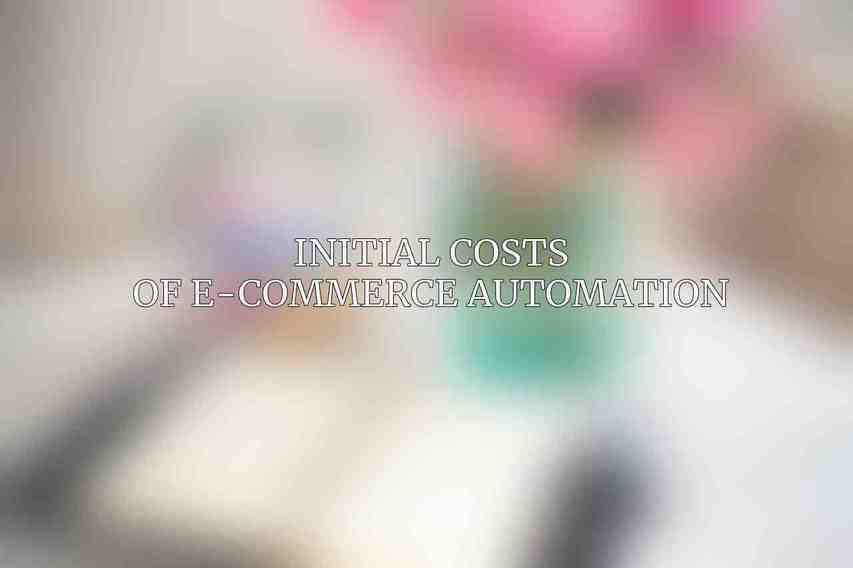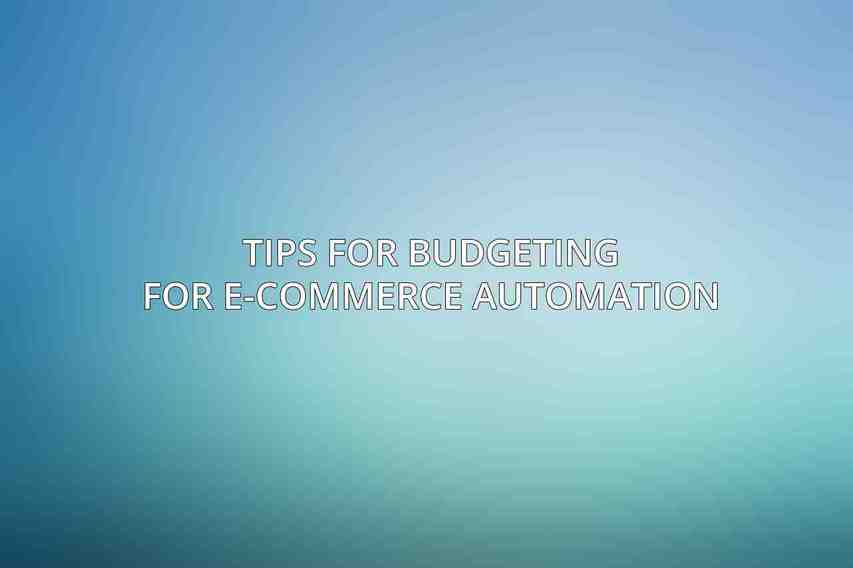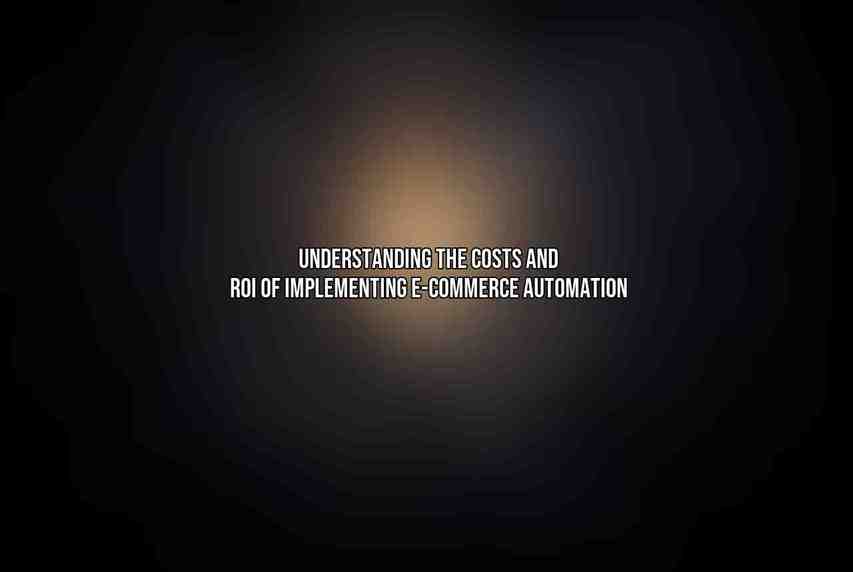e-commerce automation has become a vital tool for businesses looking to streamline their online operations. E-commerce automation involves using software and technology to automate various aspects of online selling, from marketing to order fulfillment. It allows businesses to operate more efficiently, save time, and provide better customer service. Analyzing the costs and returns on investment (ROI) of implementing e-commerce automation is crucial for businesses to make informed decisions. Get the scoop on our perspective regarding Elevating Your Multi-Channel E-Commerce Strategy with ClickFunnels Automation
One of the crucial aspects of understanding the costs and ROI of implementing e-commerce automation is conducting a comprehensive cost analysis. This involves evaluating the initial costs of setting up automation tools, as well as predicting the potential returns in terms of increased sales, cost savings, and operational efficiencies.
Initial Costs of E-commerce Automation

A. Software costs
When considering e-commerce automation, software costs are a significant factor. There are various types of e-commerce automation software available, each serving different functions within the online selling process. These include:
| Types of E-commerce Automation Software |
|---|
| Marketing automation |
| Order management |
| Inventory management |
| Customer service automation |
| Shipping automation |
The pricing models for e-commerce automation software vary, including subscription-based models, pay-as-you-go options, and one-time purchases. Explore further with How ClickFunnels Can Revolutionize Your E-commerce Product Sales Process
B. Hardware costs
In addition to software expenses, businesses also need to factor in hardware costs for e-commerce automation. This includes investments in servers, storage devices, and network infrastructure to support the automation software effectively.
C. Implementation costs
Implementing e-commerce automation also comes with additional costs such as consulting fees for expert advice, training costs to educate employees on using the new tools, and integration costs to ensure seamless compatibility with existing systems.
D. Maintenance costs
Once e-commerce automation is up and running, ongoing maintenance costs should be considered. This includes expenses for software updates, hardware maintenance, and support services to troubleshoot any issues that may arise.
Potential ROI of E-commerce Automation
A. Increased sales revenue
Implementing e-commerce automation can lead to a significant increase in sales revenue. By enhancing the customer experience, improving conversion rates, and reducing cart abandonment, businesses can attract more customers and drive higher sales volumes.
B. Reduced operational costs
Automation streamlines operations, leading to reduced operational costs. Automated order processing, decreased inventory holding costs, and improved customer service efficiency all contribute to cost savings for businesses. Discover our thoughts on Maximizing E-Commerce Efficiency: Automating Checkout with ClickFunnels
C. Improved efficiency and productivity
E-commerce automation improves efficiency and productivity by reducing manual tasks, enabling faster response times, and increasing employee satisfaction through more streamlined workflows.
D. Increased customer satisfaction
Automation enhances customer satisfaction by providing improved customer service, faster delivery times, and reducing errors in the order fulfillment process. Find out about Boosting E-Commerce Customer Engagement through ClickFunnels Automation
Tips for Budgeting for E-commerce Automation

To effectively budget for e-commerce automation implementation, consider the following tips:
- Determine your business needs and goals for automation.
- Research different software and hardware options to find the best fit for your requirements.
- Obtain quotes from multiple vendors to compare costs and services.
- Calculate the total cost of ownership, including initial setup, ongoing maintenance, and potential upgrades.
- Plan for ongoing maintenance costs to ensure smooth operation of e-commerce automation tools.
- Utilize a phased approach to implementation to manage costs and mitigate risks.
- Monitor the results of automation implementation and adjust your budget and strategy accordingly.
Case Studies and Examples
A. Case Study of a small business
One example is a small online boutique that successfully implemented e-commerce automation tools to streamline order processing, resulting in faster order fulfillment and improved customer satisfaction. By automating inventory management and integrating customer service automation, the boutique reduced operational costs and increased sales revenue.
B. Example of a large enterprise
A large enterprise in the consumer electronics industry utilized e-commerce automation to enhance its order management and shipping processes. By implementing automation software for inventory tracking and shipping logistics, the company improved operational efficiency, reduced errors in order fulfillment, and achieved higher profitability. Learn more about Inventory Management Made Easy with ClickFunnels Automation for E-Commerce
the costs and ROI of implementing e-commerce automation are essential considerations for businesses seeking to optimize their online operations. By carefully analyzing the initial costs, potential returns, and budgeting effectively, businesses can harness the power of automation to drive growth and efficiency in their e-commerce ventures. Through strategic planning and thoughtful investment, businesses can unlock the financial benefits of e-commerce automation while improving customer satisfaction and operational effectiveness.
Frequently Asked Questions
What are the key costs associated with implementing e-commerce automation?
Key costs associated with implementing e-commerce automation include initial setup costs, software licensing fees, training expenses, integration costs, potential customization expenses, and ongoing maintenance fees.
How can implementing e-commerce automation benefit a business?
Implementing e-commerce automation can benefit a business by improving efficiency, reducing human error, streamlining processes, increasing productivity, enhancing customer experiences, and ultimately leading to cost savings and increased revenue.
What factors should be considered when calculating the ROI of e-commerce automation?
When calculating the ROI of e-commerce automation, factors such as upfront costs, ongoing costs, expected time savings, increased sales revenue, reduction in manual errors, improvements in customer satisfaction, and scalability should be taken into account.
Are there any hidden costs that businesses should be aware of when implementing e-commerce automation?
Some hidden costs that businesses should be aware of when implementing e-commerce automation include costs associated with system downtime, unexpected software updates, additional training for employees, customization needs, and potential integration challenges.
How long does it typically take for a business to see a return on investment after implementing e-commerce automation?
The time it takes for a business to see a return on investment after implementing e-commerce automation can vary depending on factors such as the complexity of the solution, the level of customization required, employee training, and the efficiency gains achieved. However, businesses typically start seeing ROI within a few months to a year after implementation.

